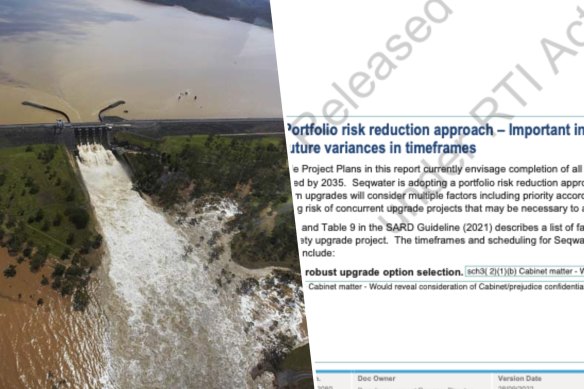- Exclusive
- Politics
- Queensland
- Water
This was published 2 years ago
Climate risks could prompt a rethink of planned SEQ dam upgrades
By Matt Dennien
The operator of south-east Queensland’s two major water supply and flood mitigation dams is waiting on research that could throw a spanner into planning work for “once-in-a-lifetime” upgrades.
Seqwater, the state-owned body tasked with operating Wivenhoe Dam and its upstream neighbour Somerset, is among several dam operators to commission the work to understand the effect of climate change on floods.

Wivenhoe dam during the 2011 floods. The research might lead to “further consideration” of its upgrade plans and risk management strategy.Credit: Dean Saffron, RTI
Global temperature rises mean the frequency and severity of floods and droughts are expected to increase.
Detail of the research and potential fallout come from a report handed to the government by Seqwater last year, under new laws requiring annual updates about upgrade works, and obtained by Brisbane Times under state right to information laws.
While engineering flood hydrology guidelines were said to have been updated to account for the effect of climate change on “common” floods, the report notes “there has been no meaningful guidance for [the] impact of climate change on extreme floods”.
What the research finds might lead to “further consideration” of the upgrade plans and risk management.
“This may require revision of the preferred upgrade option and/or considering the potential to stage the dam upgrade requirements to achieve flood capacity that can be considered ALARP [as low as reasonably practical] for dam failure risks,” the report states.
Extreme floods are defined as events expected to occur on average once every 2000 years, or with a 0.05 per cent probability of happening in any given year.
The Lockyer Valley flood of 2011 was initially estimated as a “one-in-2000-year” event based on 31 years of records.
The research, by the University of Melbourne, was expected “in or around 2023” after being commissioned in 2020.
Both dams are legally required to be upgraded by 2035, with neither having met national large dam safety standards for about two decades.
Full drinking supply levels were lowered in both years ago and will remain lower until planning and upgrade work is completed – with a detailed business case for Somerset and Wivenhoe in the “early stage of planning”.
Undecided final design options for both have been suggested to include spillway upgrades and wall raisings.
The Seqwater website notes that Somerset work could take five years after government funding approval. Department officials have said “best practice” was generally between five and 10 years.
The new document features sections detailing the “need for robust upgrade option selection”, works required and timeframes. Almost all were redacted as matters likely to “inform future cabinet deliberations”.
It lists the need to manage risks of “concurrent upgrade projects that may be necessary” to meet the 2035 deadline – rather than the initial plan to focus on Somerset first – while balancing water supply and flood concerns against the climate before and during construction.
Reports have warned that dam operators had not managed the risk of delay an expected $4.6 billion bill for statewide upgrades could pose, with new water sources – a dam, desalination plant or recycled water – needed for the south-east Queensland population unable to be covered by current supply.